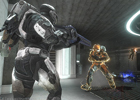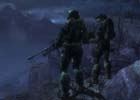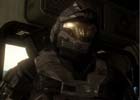Halo: Reach
| Genre: Action Adventure/Shooter | ||
| Platform(s): Xbox 360 | ||
| Allegiance: Bungie | ||
| Vintage: 2010 | ||
| Rating: M | ||
| Intelligence Agency Report by: Shadow | ||
| You are Noble 6, the newest member of Noble Team. You’re a “hyper lethal vector” that the Office of Naval Intelligence (ONI) brass has decided to move to a new squad in the defense of the planet Reach. You’re shrouded in mystery, and blocks of black ink mark the records on you that your commander has defied orders to find. You will fight for survival as your squad mates begin to fall and the situation on Reach becomes dire. The game opens up with a grim scene: your helmet has a big hole in the middle of the visor and it looks like it was used to beat you to death. Bungie has already told you what kind of affair you are in for. This time, you return as Noble 6, a SPARTAN-III newly placed into Noble Team with Jorge (the tank), Emile (the closed-quarters specialist), Jun (the sniper), Kat (the tech wizard and second in command), and your leader, Carter. These warriors take no crap, and have every intention of dealing with insurgents as well as the Covenant. Reach is currently believed to be cut off from the planetary network by the rebel forces, but Noble is the first to discover that the Covenant have come to Reach.
Noble Team becomes wrapped up in the attempt to save Reach from the Covenant. It is discovered that the Covenant have brought a full invasion army to the planet. Noble Team travels deeper into the territory in an attempt to squash the invasion quickly, only to have their forces decimated by a Covenant Super-Carrier. From there, Noble 6 makes plans to take out the Super-Carrier, their true past comes out, and the SPARTANs plan to save Reach. The rest is what you’ll have to play on your own. |
||
|
|
||
| Weapons Expert Report by: Shadow | ||
| Story/Premise Gameplay Impact Visual Audio |
9.00 10.00 10.00 9.00 9.25 |
|
| Overall | 9.50 | |
| (not an average) | ||
| Version Reviewed: XBox 360 Halo 3: ODST felt like a divorce for the faithful of the Halo series. This may seem like a vicious statement, which it is, and it’s false. ODST was meant to be a tie-in game while Bungie worked on Halo: Reach. So why did they turn out something like ODST that took away the characters you knew and loved and removed the regular game play you had come to enjoy as an ass-kicking SPARTAN-II? So that they could focus their time on Reach but give you a game to keep your interest while Infinity Ward was running around dominating shooters with Call of Duty. And yes, the wait was very much worth it. The first major change that you will find to Halo: Reach is one that will take some time to get used to. If you’ve played Halo for a long time, then you’re familiar with what was the OLD controller layout. I will warn you now that things have been changed around, but I assure you that they have changed around for the better. The controls seem to be a bit more intuitive and related actions are linked to closely-grouped buttons, allowing you to function in combat a bit quicker. The next change that you will notice is the level of detail that went into the graphics for this game. The graphics are sharp; you can see plasma burns, bullet holes, and scratches in your armor. And changes that you make to your PERSONALIZED character actually are shown in campaign mode itself.
The only major drawback to the game is one that has been in there since the very beginning – you dance! A lot! You know what I’m talking about, where you sit there and constantly move in the middle of combat instead of being able to properly duck behind cover and fight. A lot of open space combat continues to be a portion of Reach which forces you to be constantly on the move. At the same time, it adds a fun aspect to going combat berserk when you start running into the Covenant with your assault rifle on full auto and tearing them limb from limb. Another, more minor, drawback to the game is the customized items that you can get. There is nothing wrong with the items except that to get them, you have to attain a certain rank and have a certain amount of credits to buy them while they offer you absolutely no advantages at a disproportionate cost. Though this is the last Halo game that Bungie will be making, since they’ve let the contract expire, they made sure that they’d go out with a bang. They left plenty of Easter Eggs in the game for the players, as well as a cameo for Master Chief. It’s an emotionally charged game that at one point made me ask a friend, “Is it me, or is each loss making me feel like I got a bigger kick in the balls?” That emotional level continues to get the player further involved into the game so much that you begin to actually hate the Covenant forces. Aside from the campaign, there are various other modes to keep players entertained. An expanded Forge mode allows players to create their own maps and unique battle conditions in the game modes used within it. Players will enjoy the return of the Firefight mode, which can provide hours of fun while helping to build the credits to earn custom items for your character. Of course multiplayer, a major portion of the Haloseries, is in the game and will also help to build credits. These modes make the game worth playing over and over, yet Reach puts in two things that makes it worth playing the campaign again and again: challenges and commendations. These challenges and commendations, which act as achievements, are in all three modes of Reach, and as you complete them based on the conditions, you get even more extra credits. There are very few issues with Reach, and Bungie has earned a lot of praise for this wonderful game. They have not left the fans disappointed with this game (unless you’re a Halophile that is die-hard on the novels) and it is a sendoff to this series that will be remembered for a very long time. It’s worth spending the money to buy because renting the game will mean you’ll waste money on something you will buy anyway.
|
||




